



by Steven Nyland, OrganicCrops. Posted on 30 March 2017, 16:42 hrs
Discover the wonders of importing from Peru, a country that has emerged as a powerhouse in the agricultural export industry. With a rapidly growing economy and remarkable stability in the Latin American region, Peru has captured the attention of consumers worldwide. The bountiful offerings from the Peruvian Andes and lush jungle regions have sparked a global fascination with their delectable and nourishing products. As a result, an increasing number of companies are choosing to import from Peru. From the renowned quinoa to the exquisite raw cacao nibs made from Criollo cacao beans, as well as sought-after treasures like dehydrated aguaymanto, camu camu powder, and sacha inchi oil, Peru has cemented its reputation for producing exceptional organic food products. Join us as we delve into the comprehensive guide on importing from Peru, unlocking a world of quality and flavor.
As a trusted exporter of Peruvian superfood products, we understand the importance of addressing the inquiries and concerns that arise during the export process. We regularly encounter a diverse range of questions, covering topics such as commercial transactions, sample requests, quantities, certifications, and the necessary export paperwork. While each export situation may present unique circumstances, we have compiled a comprehensive set of information to address the most frequently asked questions. Our goal is to provide clarity and guidance, ensuring that our clients have a clear understanding of the export process and the steps involved. With this valuable resource, we aim to assist you in navigating the intricacies of exporting from Peru, enabling a smooth and successful trade experience.
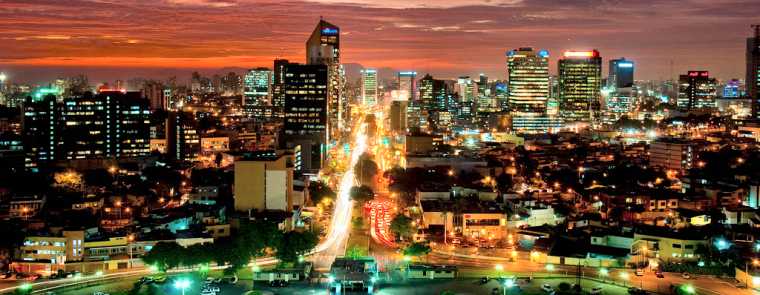
Peru, the third largest country in South America, boasts abundant natural resources and is divided into three distinct regions: the coast, the highlands, and the jungle. With an estimated combined population of 31.2 million (2015), approximately 80% of Peruvians reside in urban areas, with one-third living in the capital city of Lima. While Spanish is the official language, many regions of Peru still widely speak Quechua. The currency used is the Nuevo Sol, denoted as "S/", with a currency code of PEN. Peru's exchange rate, driven by non-speculative market forces, remains one of the most stable in Latin America.
Peru has shown a strong commitment to free trade, resulting in its emergence as one of the fastest-growing economies in Latin America. With a GDP of around US$181 billion (2016 est.), Peru has maintained an average annual growth rate of 5.6% over the past five years, reaching just over 5% in 2013. It has consistently recorded the highest growth rate and the lowest inflation in the region over the past decade. As the economy has flourished, poverty levels in Peru have steadily declined. However, while Peru remains a leading force in economic growth in the region, its per capita GDP still lags behind neighboring countries.
 Peru has actively embraced free trade, with over 80% of its trade covered by Free Trade Agreements (FTAs) with entities such as the European Union, the United States of America, Canada, and many Asian countries. The country played a pivotal role in founding the Pacific Alliance bloc and continues to actively participate in negotiations for the Trans-Pacific Partnership.
Peru has actively embraced free trade, with over 80% of its trade covered by Free Trade Agreements (FTAs) with entities such as the European Union, the United States of America, Canada, and many Asian countries. The country played a pivotal role in founding the Pacific Alliance bloc and continues to actively participate in negotiations for the Trans-Pacific Partnership.
Renowned for its exceptional biodiversity, Peru is ranked among the top ten most biodiverse countries in the world, housing 84 out of the 117 recognized life zones on the planet. This ecological diversity provides Peru with a significant advantage, as crops can be cultivated year-round. With over 8 million hectares available for agricultural cultivation, Peru has emerged as a major player on the global agriculture stage.
When engaging in business with Peru, the process is similar to conducting business with other countries. While some small private sector companies may have English-speaking personnel, the majority of businesses primarily communicate in Spanish. As a result, it may take some time to receive a response. Peruvian business culture values tradition and may be more resistant to new developments or changes.
Understanding the background and business landscape of Peru sets the stage for successful partnerships and endeavors within the country's thriving agricultural sector.
Ensuring that the products you import from Peru have been cultivated and produced organically is crucial. To verify their organic status, you can request a copy of the organic certification documents issued by internationally recognized quality control and certification bodies such as Control Union, EcoCert, Ceres, or Kiwa. These organizations have offices or representatives in Peru, making it easier to access the necessary documentation. As an importer, you can also request a transfer certificate for a small fee, further validating the organic credentials of the products.
In addition to the organic certification, we highly recommend asking for a batch-specific Certificate of Analysis (COA). This document provides detailed information about the specific batch of the product, including test results and analysis. At OrganicCrops, we utilize GroenAgro, a reputable testing facility based in the Netherlands, for comprehensive testing against all known pesticide markers. The testing process, including the issuance of an extensive report and certificate, typically takes around one week and incurs a cost ranging from USD 200 to 400. This thorough testing ensures that our products meet the highest organic standards and provide you with peace of mind regarding their quality.
By requesting the organic certification documents and a batch-specific COA, you can confidently ascertain that the products you import from OrganicCrops have been cultivated and produced organically, meeting your expectations for premium organic goods.
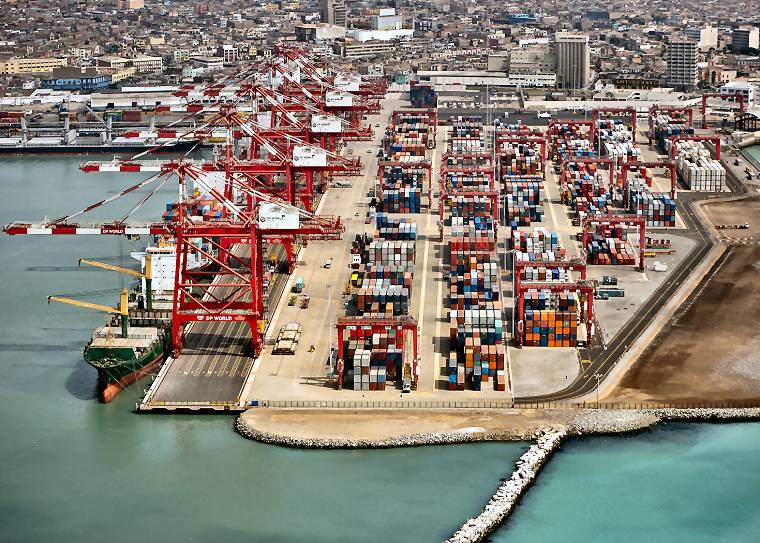
The Minimum Order Quantity (MOQ) is determined based on various factors, including the cost of exporting and logistical considerations. In the case of Peru, the main exporting harbor is often the port of Callao (Lima), which incurs significant local costs. Freight agents and handling companies at Callao charge by the hour or part of a day, making it one of the most expensive harbors in the world.
Dry agricultural products, such as cacao powder, maca powder, sacha inchi powder, and others, undergo extensive customs and narcotics inspections during the export process. This inspection process involves unpacking the pallets, placing the bags or boxes in specific inspection areas, and often taking product samples for laboratory testing. Once the inspection is completed, the bags/boxes are repacked, pallets are reassembled, and returned to the warehouse. This operation can take anywhere from 2-3 hours to a few days to complete.
For small shipments, such as 100 kg, the costs associated with clearing customs, transportation, storage, loading, and other logistics can amount to approximately USD 1000. However, a 20-foot container with 10,000 kg on pallets usually incurs costs of around USD 2000. Thus, the difference in port and handling costs between a shipment of 100 kg and 10,000 kg is only USD 1000. When factoring in the additional expenses for obtaining the necessary export paperwork, the per kg product price can significantly increase.
To ensure cost efficiency and make the export process viable, a Minimum Order Quantity is set. This quantity allows for the consolidation of shipments, reducing the individual cost per unit and making the export process more economically feasible for both the exporter and importer.
Understanding the rationale behind the Minimum Order Quantity helps shed light on the logistical and cost considerations involved in exporting from Peru. By optimizing shipment sizes, we can provide you with competitive pricing while maintaining the quality and integrity of our products. See below example calculation:
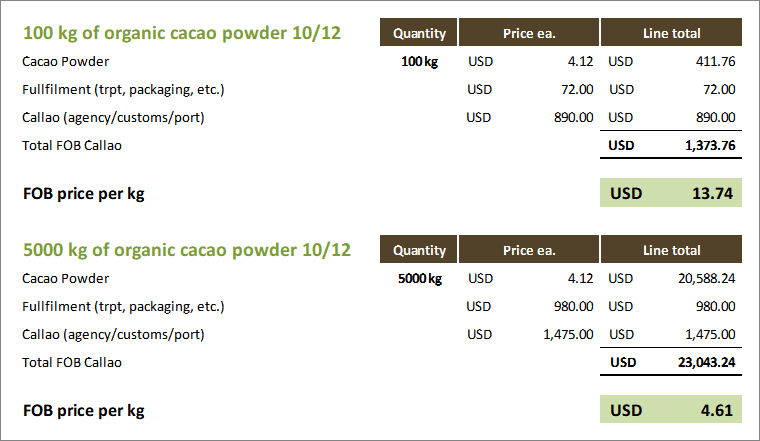
The above pictured example applies specifically to exporting via ocean freight. However, it's important to note that when using air freight, the cost of exporting is generally lower, while the actual freight cost tends to be higher. This dynamic makes air freight a more cost-effective option for smaller quantities.
When dealing with small quantities, opting for air freight can yield advantages in terms of cost efficiency. While the overall export expenses may be lower, it's important to consider that the freight cost itself will be higher due to the nature of air transportation.
By leveraging air freight for smaller quantities, importers can enjoy reduced export costs while ensuring a quicker delivery time. This flexibility allows for more tailored and efficient logistics management, optimizing the transportation process based on the specific needs and requirements of each shipment.
At OrganicCrops, we understand the importance of offering both ocean and air freight options to accommodate the varying needs of our clients. Whether it's large-scale orders or smaller quantities, we strive to provide cost-effective solutions that maintain the integrity and quality of our products throughout the entire export process.
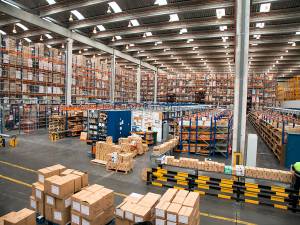
By leveraging these methods, you can ensure that the products you import meet your desired quality standards. Whether through firsthand evaluation of samples, third-party quality assurance checks, or internal quality control measures, taking proactive steps to assess product quality is crucial in establishing a reliable supply chain and delivering exceptional products to your customers.
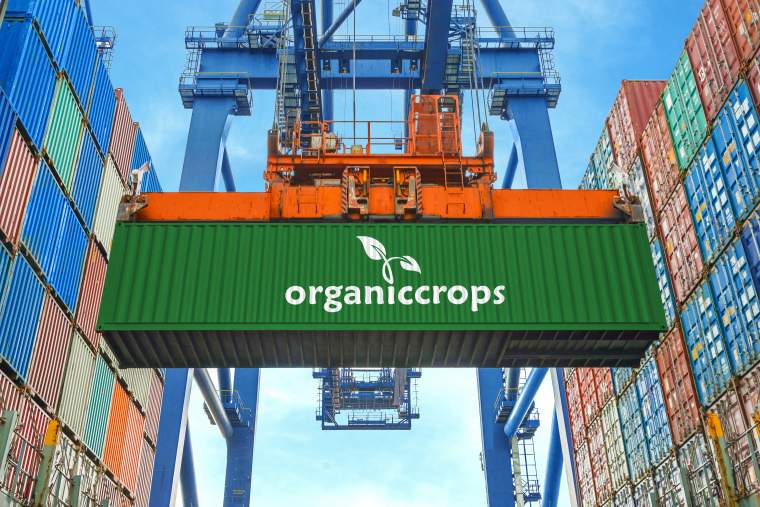
To further understand payment terms and security measures, we recommend referring to reputable resources such as opentoexport.com, hofstra.edu, and foreign-trade.com. These sources provide valuable insights into pricing, payment options, and securing the transaction process.
By familiarizing yourself with payment terms, understanding INCO terms, and researching best practices, you can ensure a secure and reliable transaction process when importing from Peru.
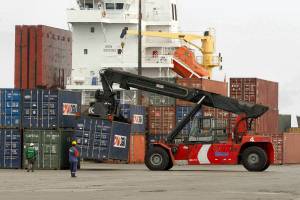 At OrganicCrops, we primarily offer prices on an FOB basis. However, we also publish a monthly price document that states prices as EXW. If desired, FOB can be manually added to combine products based on your specific buying requirements. It's important to note that local destination charges are typically not included in quotations provided by exporting companies. To obtain a comprehensive quote that covers local costs, customs, duty, unloading, clearing, documentation, and transport, it is recommended to consult with a local freight agent.
At OrganicCrops, we primarily offer prices on an FOB basis. However, we also publish a monthly price document that states prices as EXW. If desired, FOB can be manually added to combine products based on your specific buying requirements. It's important to note that local destination charges are typically not included in quotations provided by exporting companies. To obtain a comprehensive quote that covers local costs, customs, duty, unloading, clearing, documentation, and transport, it is recommended to consult with a local freight agent.
Understanding the nuances of pricing terms such as FOB, EXW, CFR, CIF, and FCA allows you to make informed decisions when negotiating and finalizing import agreements. It is advisable to consult with freight agents and freight forwarding companies to obtain accurate and detailed quotations that encompass all relevant costs associated with your specific import requirements.
Product Export Lead Time: The duration required for exporting products varies depending on the specific product. The lead time refers to the time it takes to complete the necessary clearance procedures and load the goods onto the vessel or airplane. Some products are already packaged in bulk/export packaging and stored in warehouses, ready for export. Others are processed to order, sometimes at facilities located a 2-3 day drive away from Callao, Lima. As an importer, it is essential to inquire about the lead time for your desired products. At OrganicCrops, we maintain a minimum lead time of 8-10 days for all orders, allowing us to efficiently handle export paperwork, certifications, inspections, and other necessary arrangements. For orders requiring a Certificate of Analysis (COA), an additional 5-7 working days should be considered to allow for sample testing in the Netherlands.
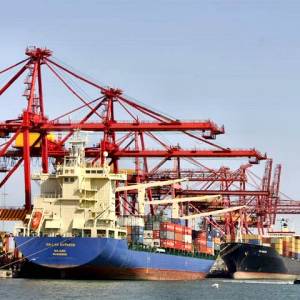 Ocean Freight: In the case of ocean freight, the port of Callao operates with a cut-off time ranging from three to five days. This means that the shipment must be present at the port of Callao at least three days before the scheduled departure of the vessel. This timeframe allows sufficient time for customs inspections, SENASA phytosanitary inspections, loading procedures, and logistical planning. However, customs may occasionally order additional inspections, which can potentially result in shipping delays.
Ocean Freight: In the case of ocean freight, the port of Callao operates with a cut-off time ranging from three to five days. This means that the shipment must be present at the port of Callao at least three days before the scheduled departure of the vessel. This timeframe allows sufficient time for customs inspections, SENASA phytosanitary inspections, loading procedures, and logistical planning. However, customs may occasionally order additional inspections, which can potentially result in shipping delays.
Air Freight: The export procedure for air freight shipments follows a similar process to that of ocean freight, with faster loading and clearing times. It's important to note that airlines often prioritize fresh produce shipments over dry-goods shipments. As a result, dry-goods shipments may occasionally be rescheduled to accommodate the prioritized cargo. Rest assured, we will keep you well-informed of any updates regarding the shipping progress.
By understanding the lead time required for exporting products, as well as the specific procedures and considerations involved in both ocean and air freight shipments, you can effectively plan your import activities and anticipate any potential shipping delays. We strive to provide transparent and timely communication, ensuring that you are informed throughout the shipping process.
Peru's Commitment to Trade: Peru's government has actively worked to reduce trade barriers, with more than 85% of its trade covered by Free Trade Agreements (FTAs) that include Europe, the USA, and many countries in Asia. This commitment to open trade has facilitated smoother import and export processes.
As part of our commitment to transparent and compliant trade practices, OrganicCrops issues a comprehensive set of documents with each export order. These documents ensure compliance with regulatory requirements and facilitate smooth customs clearance. The documents we provide include:
At an additional charge, we offer optional documentation such as a Phytosanitary Certificate, Batch/Lot-specific Certificate of Analysis (COA) provided by GroenAgro in the Netherlands, OrganicCrops Quality Control Certificate, and Organic (Transfer) Certification, as well as other cultivation documentation such as Kosher and Fairtrade certifications.
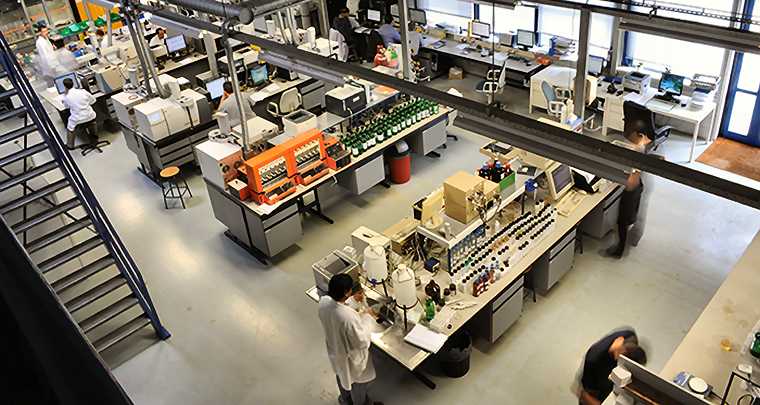
SENASA, Peru's National Agricultural Health Service, operates under the Ministry of Agriculture and is responsible for regulating and controlling food safety, agricultural safety, and organic production. Similar to the FDA in the United States, SENASA conducts inspections, provides guidance, and enforces regulations. SENASA carries out phytosanitary inspections upon request and issues phytosanitary certificates, which are mandatory for certain exports, such as quinoa and chia.
If your country has specific documentation requirements, OrganicCrops will make every effort to comply. Importing countries often have specific regulations regarding labels, export letters, responsibility statements, and more. Please notify us in advance to allow sufficient time to organize any additional required documents.
Delivery of Export Documentation: For orders with an FOB value of USD 50,000 or more, the paperwork is sent separately via courier. For orders with an FOB value below USD 50,000, the documents are emailed as PDF copies. In the case of air freight shipments, the documents are always sent alongside the shipment.
At OrganicCrops, we prioritize regulatory compliance and strive to provide all necessary export documentation to ensure smooth customs clearance and a seamless importing process for our clients.